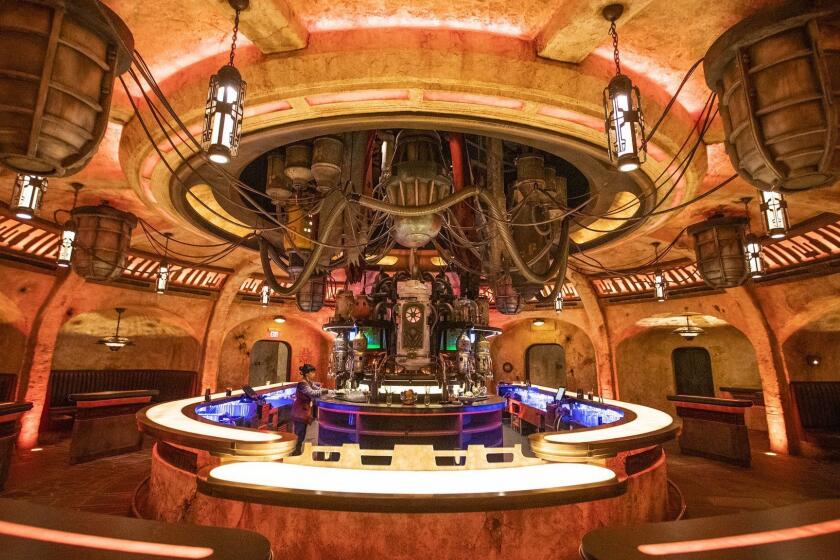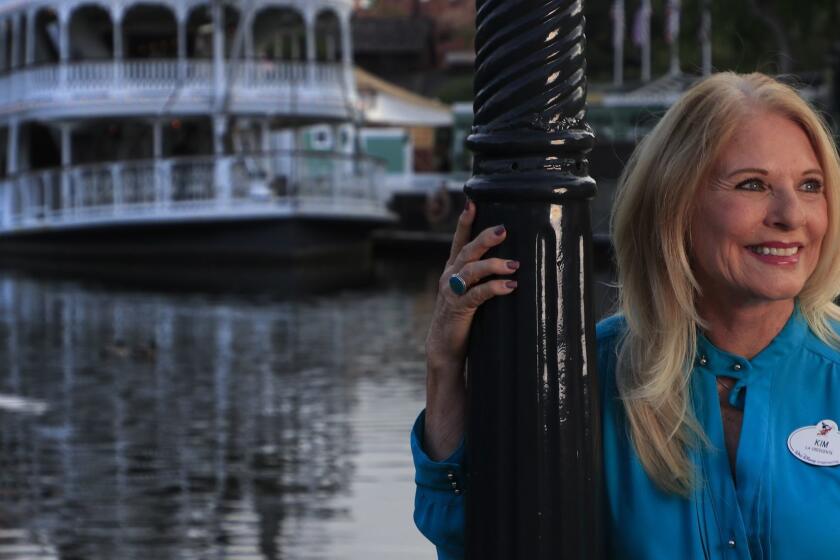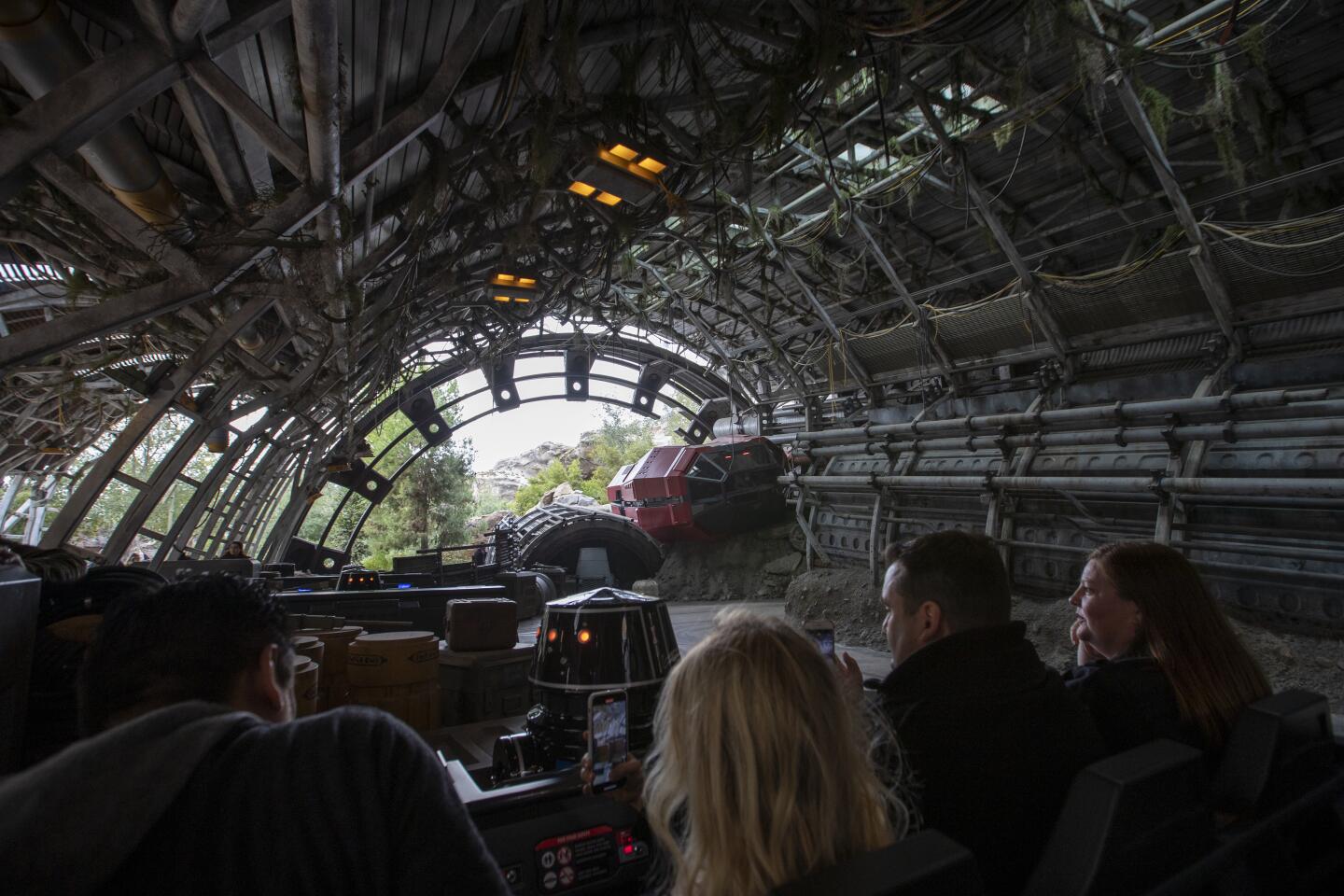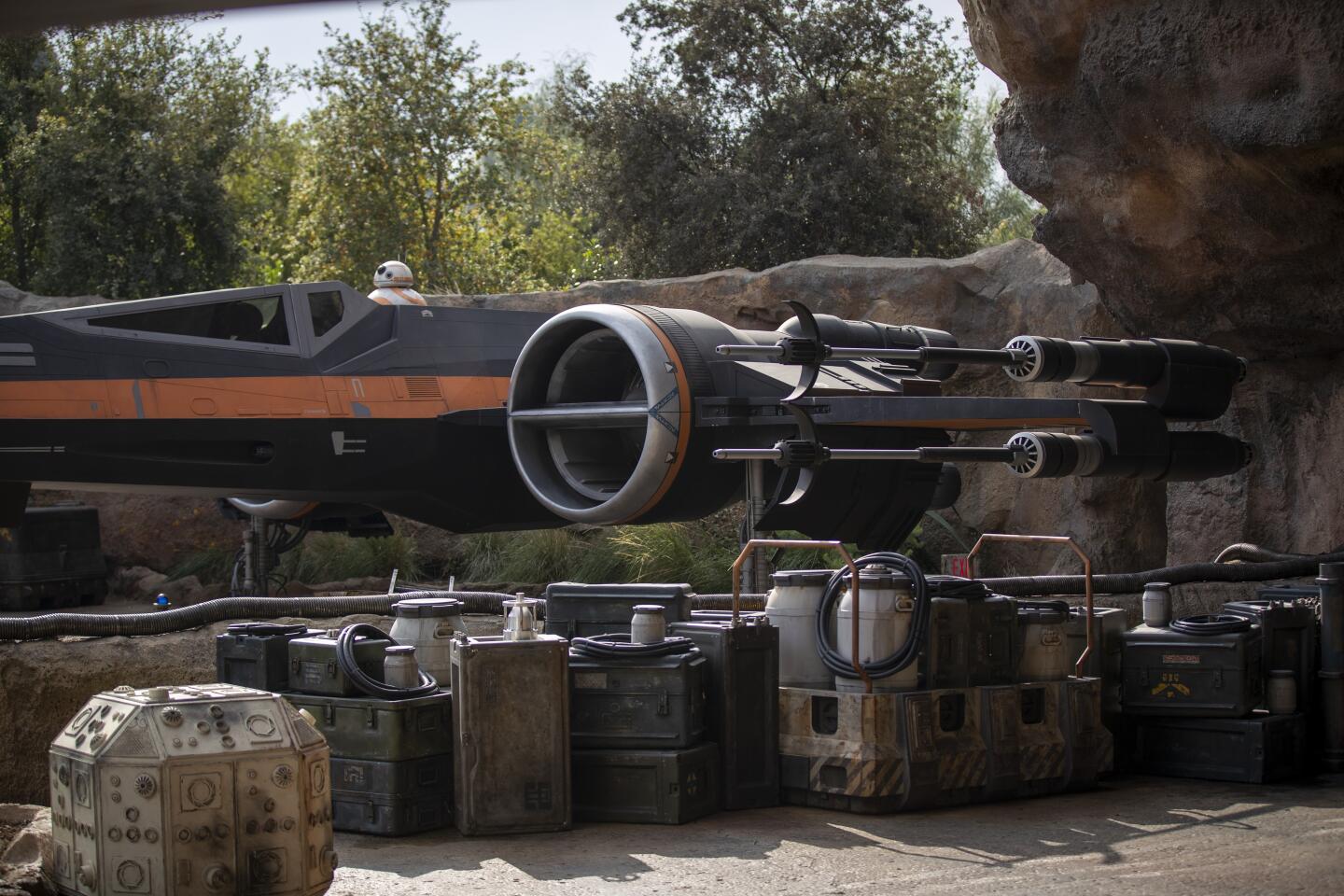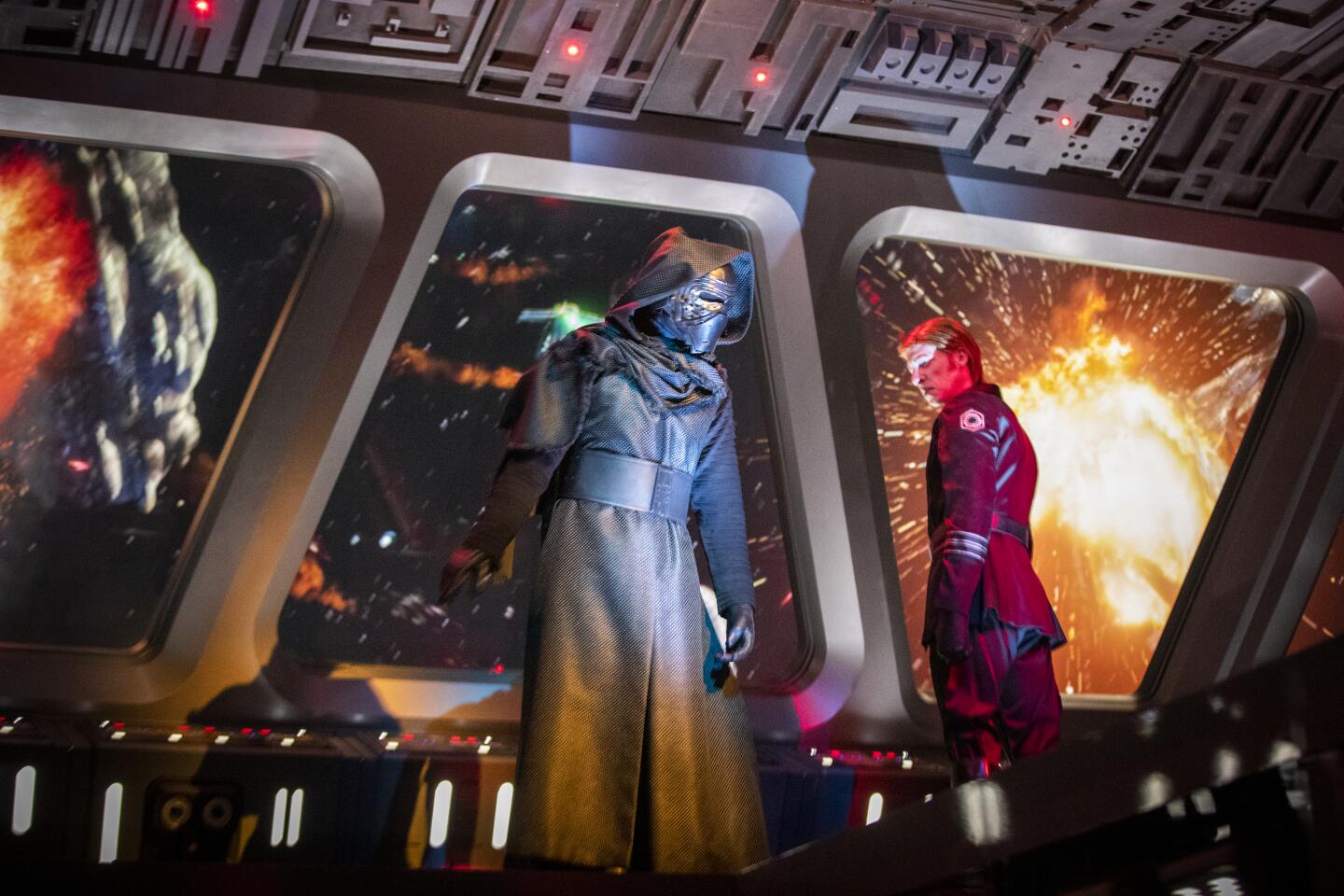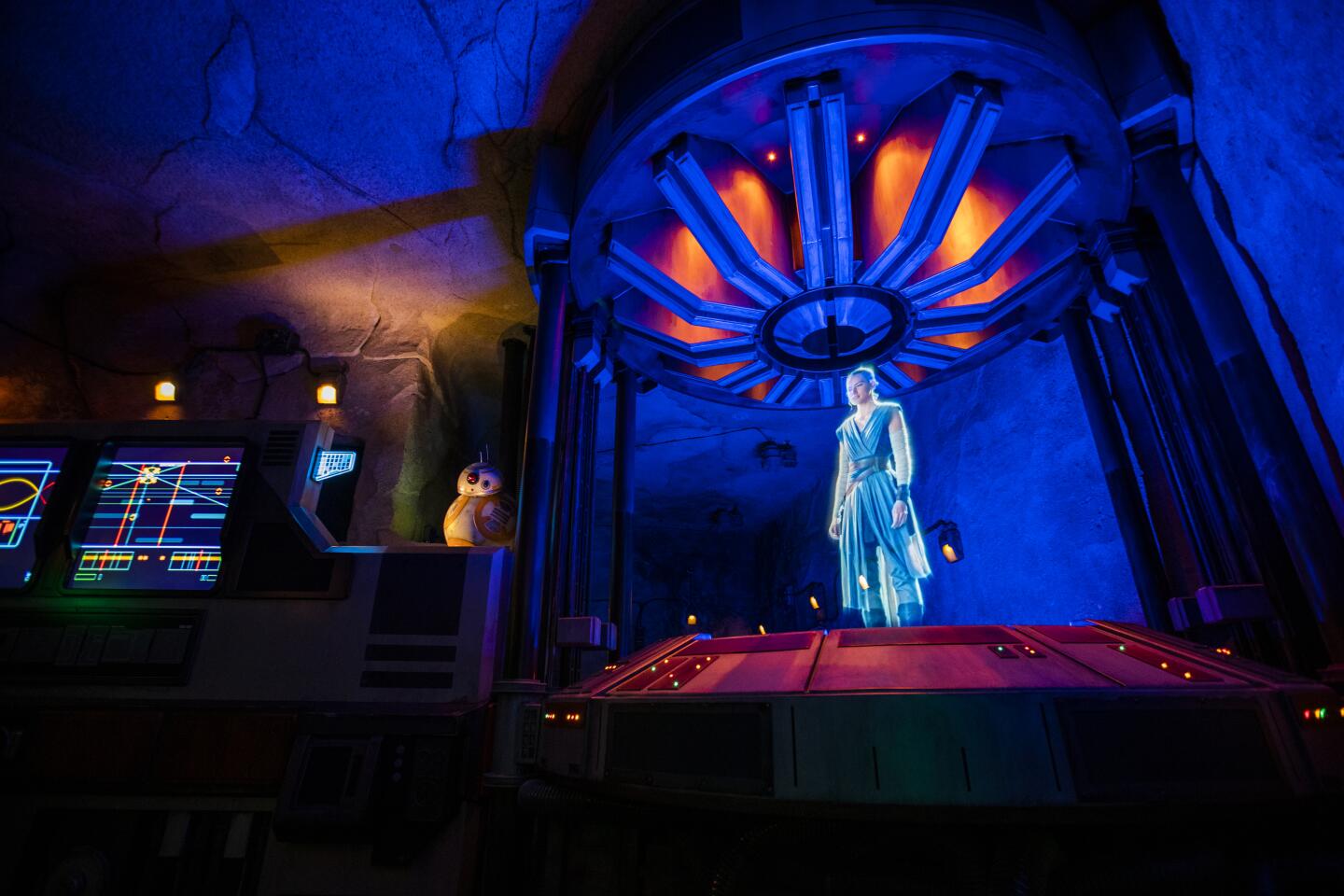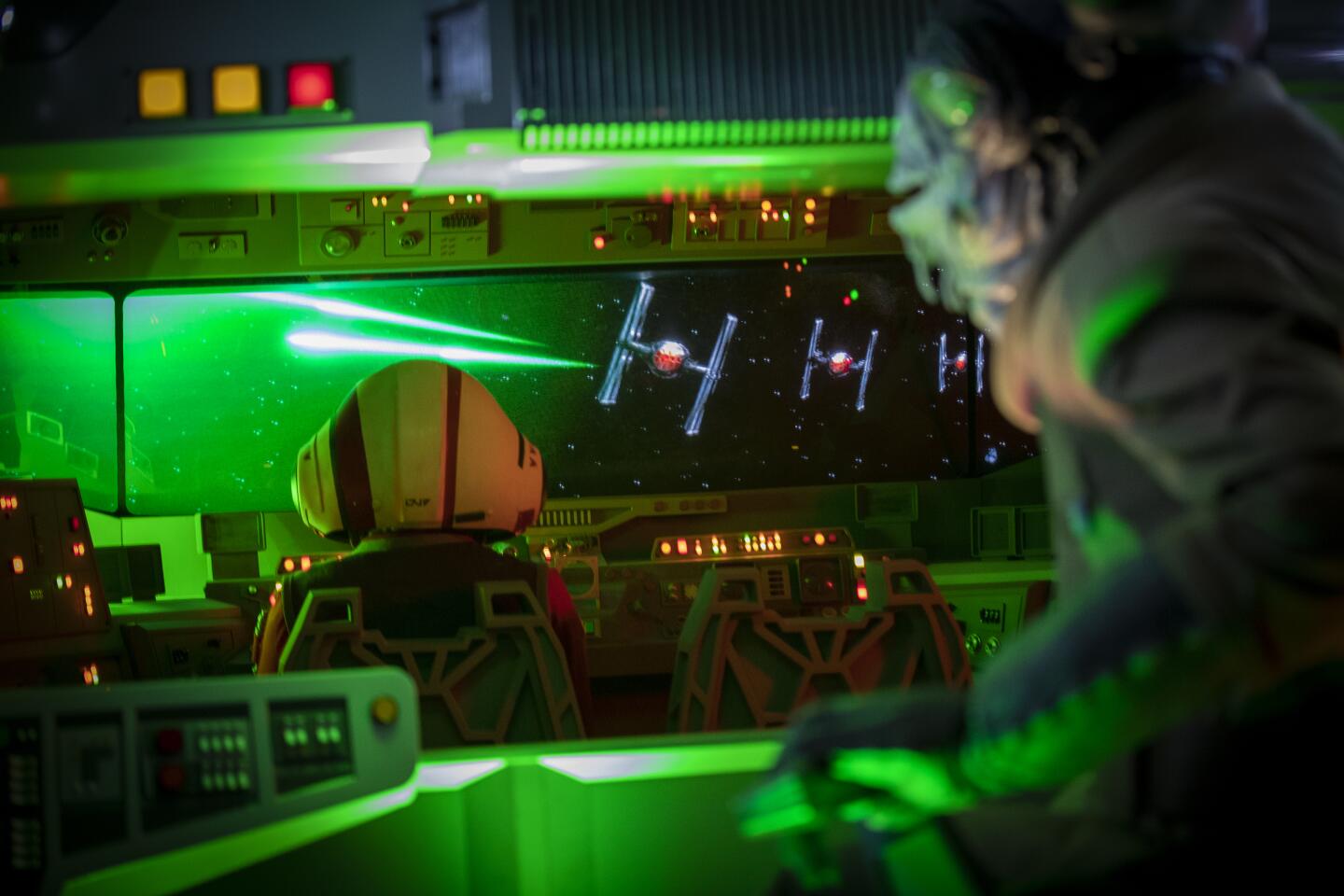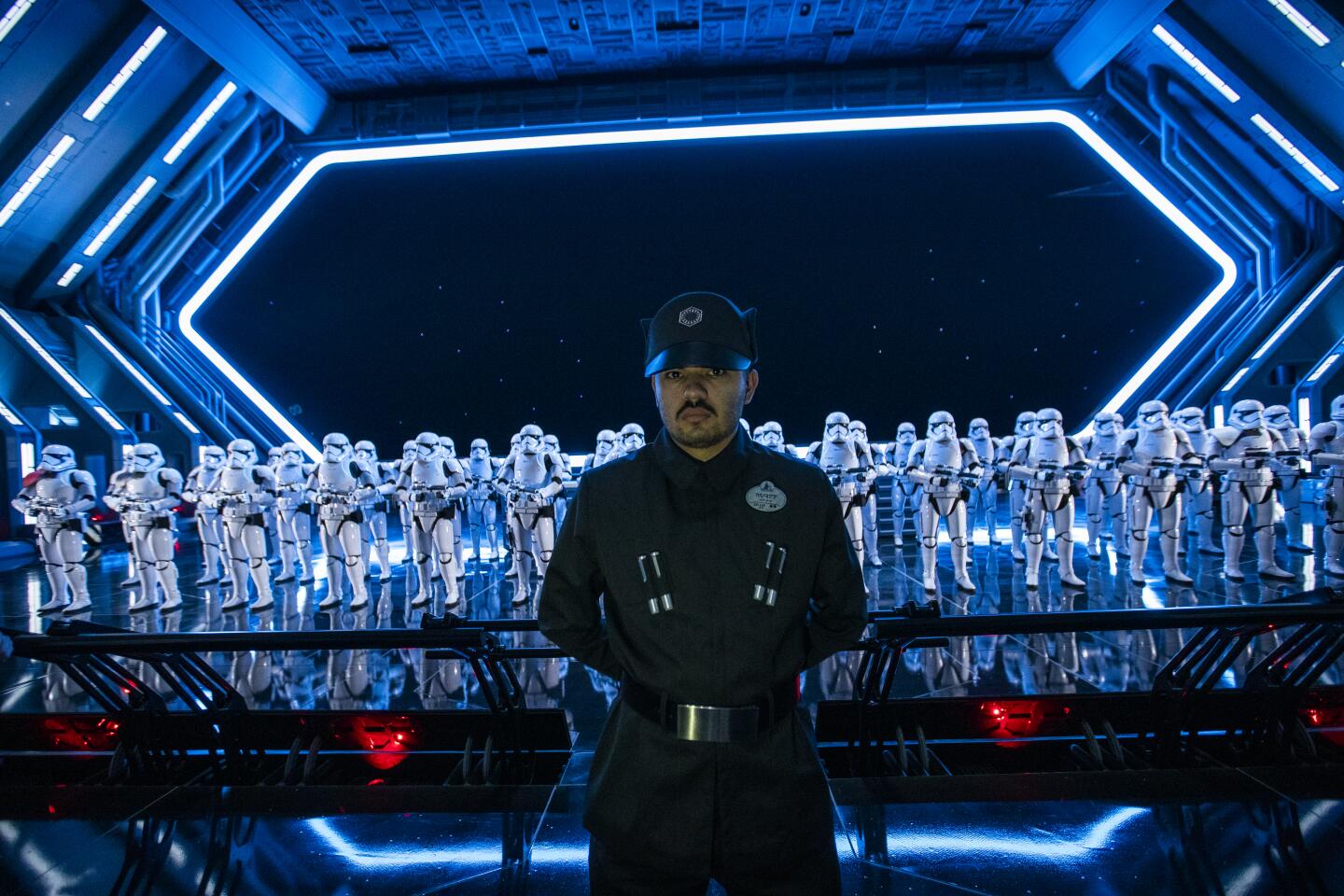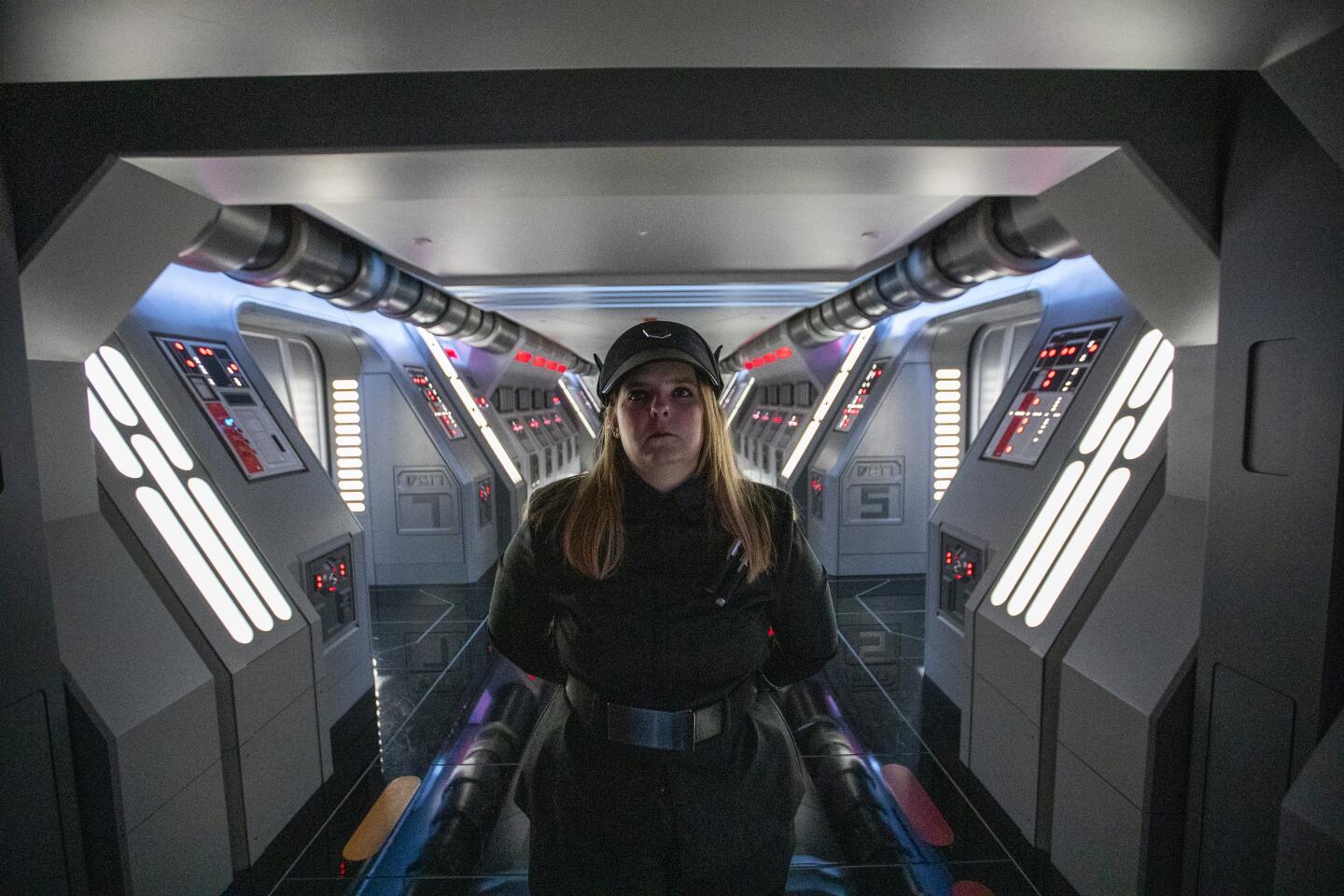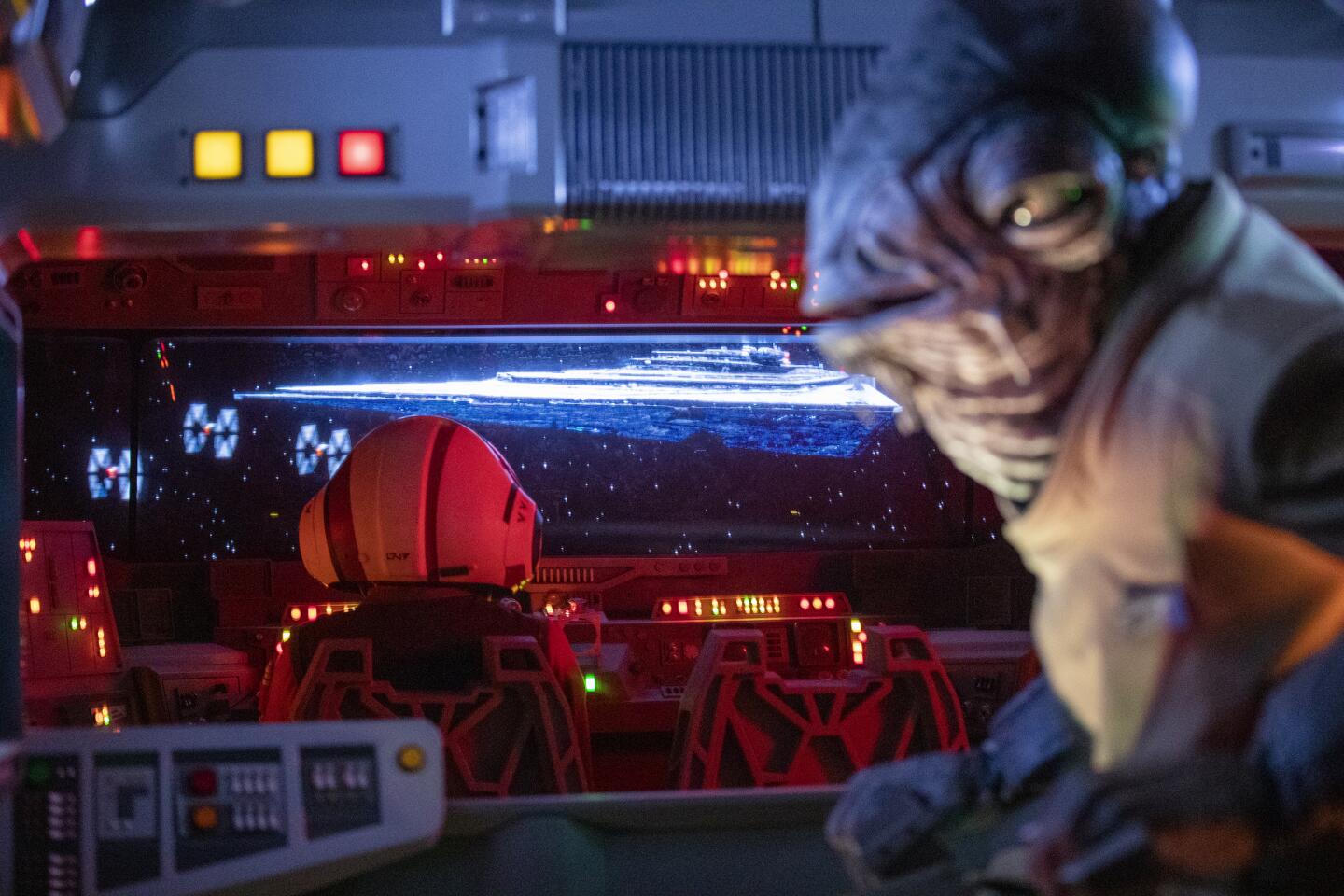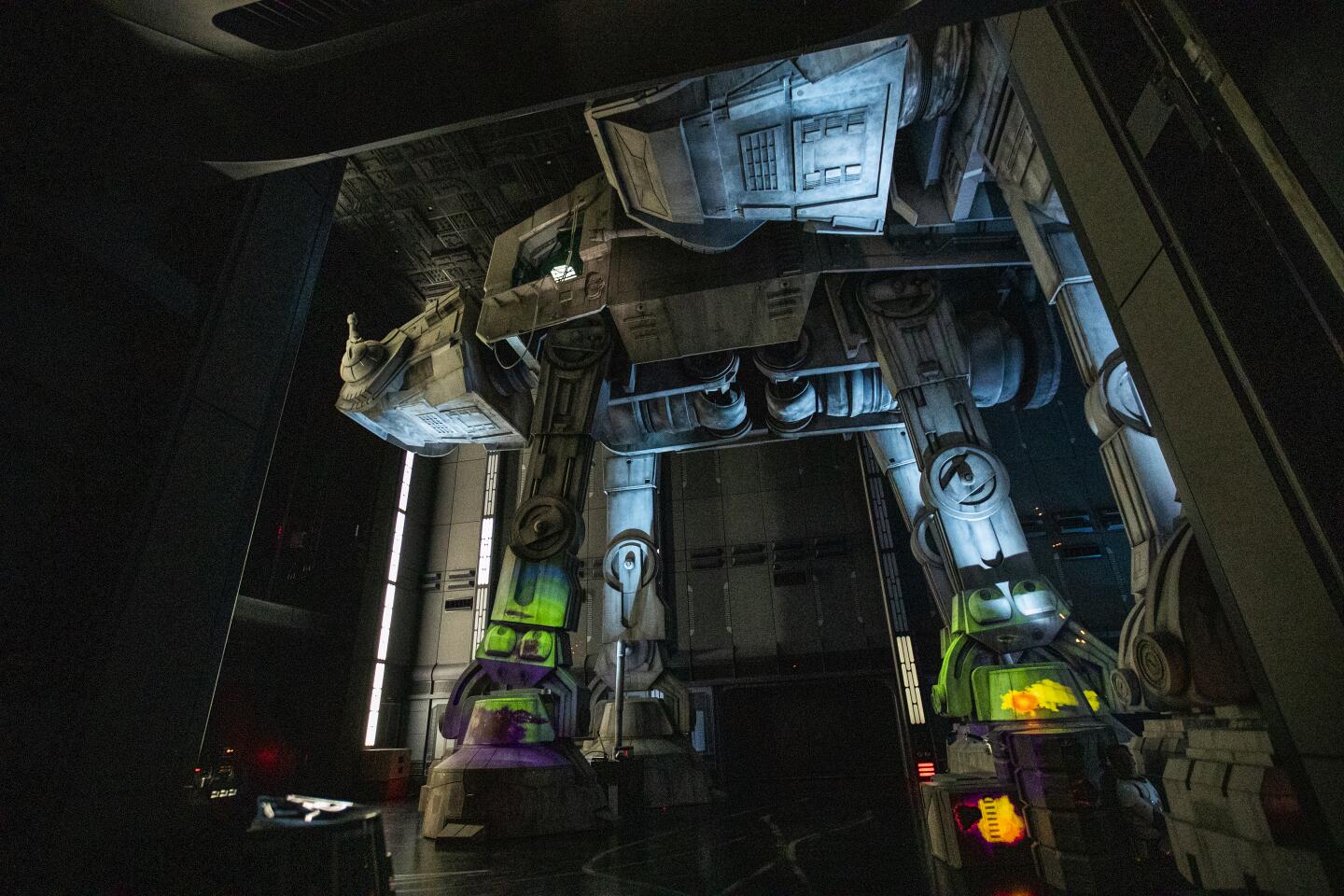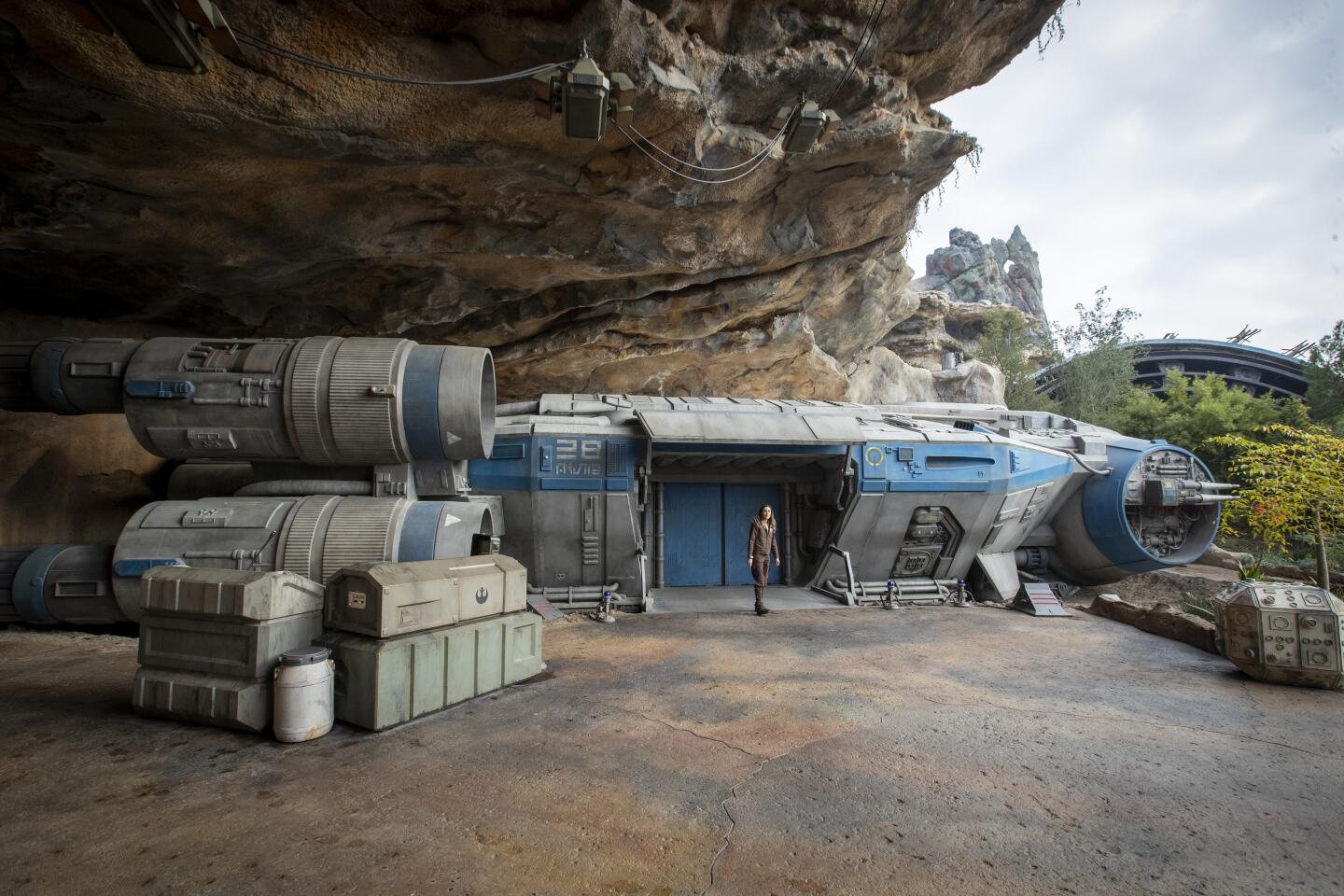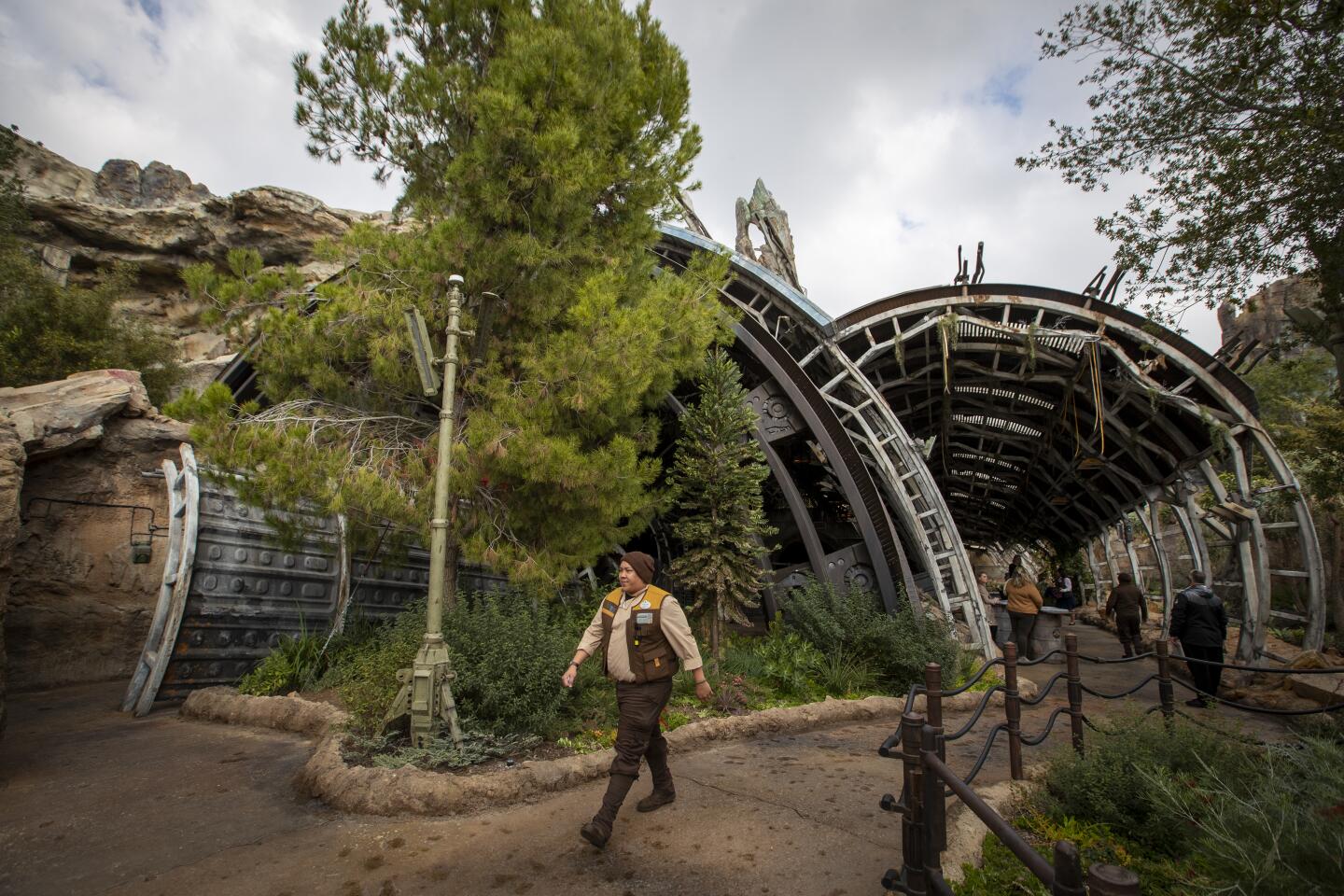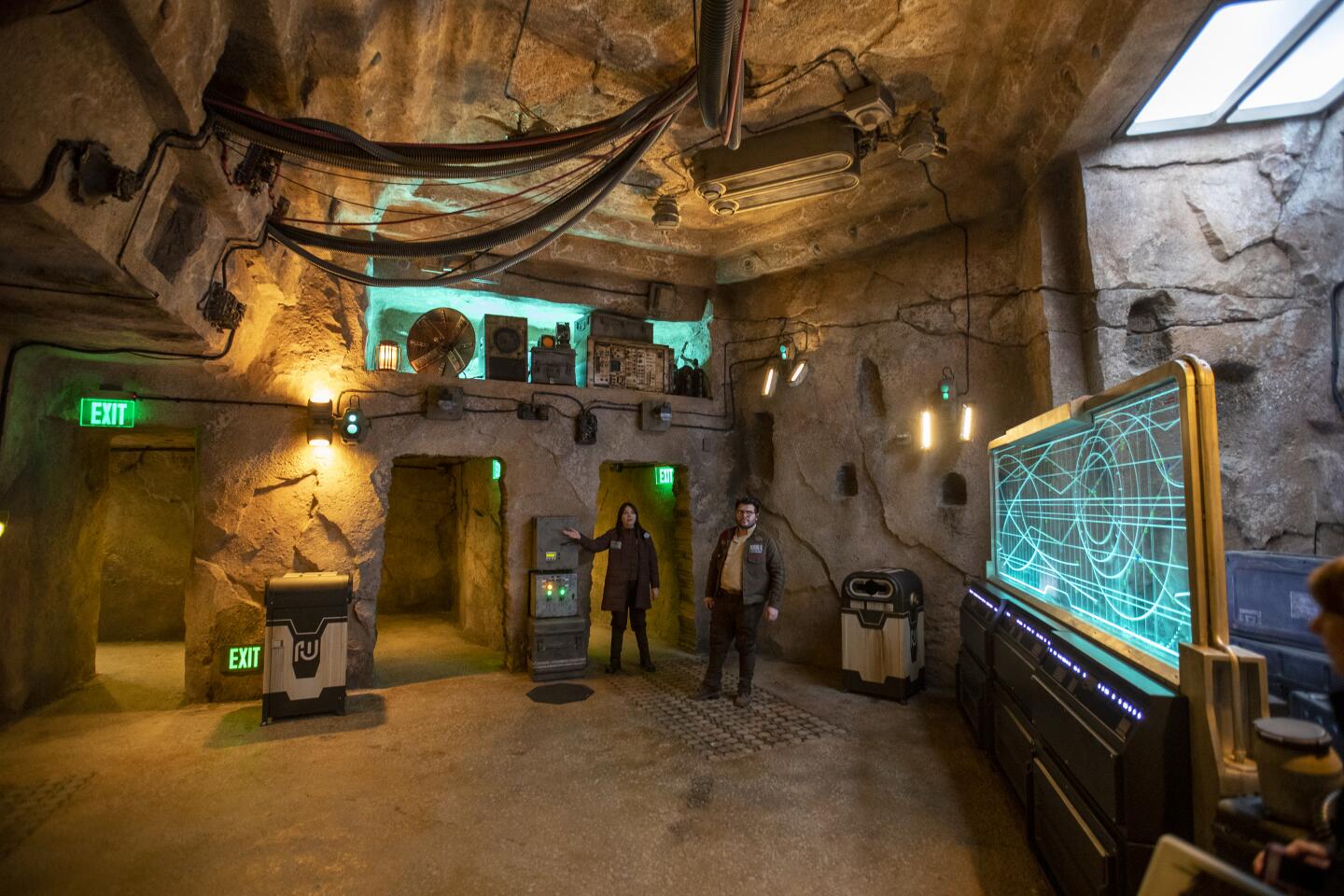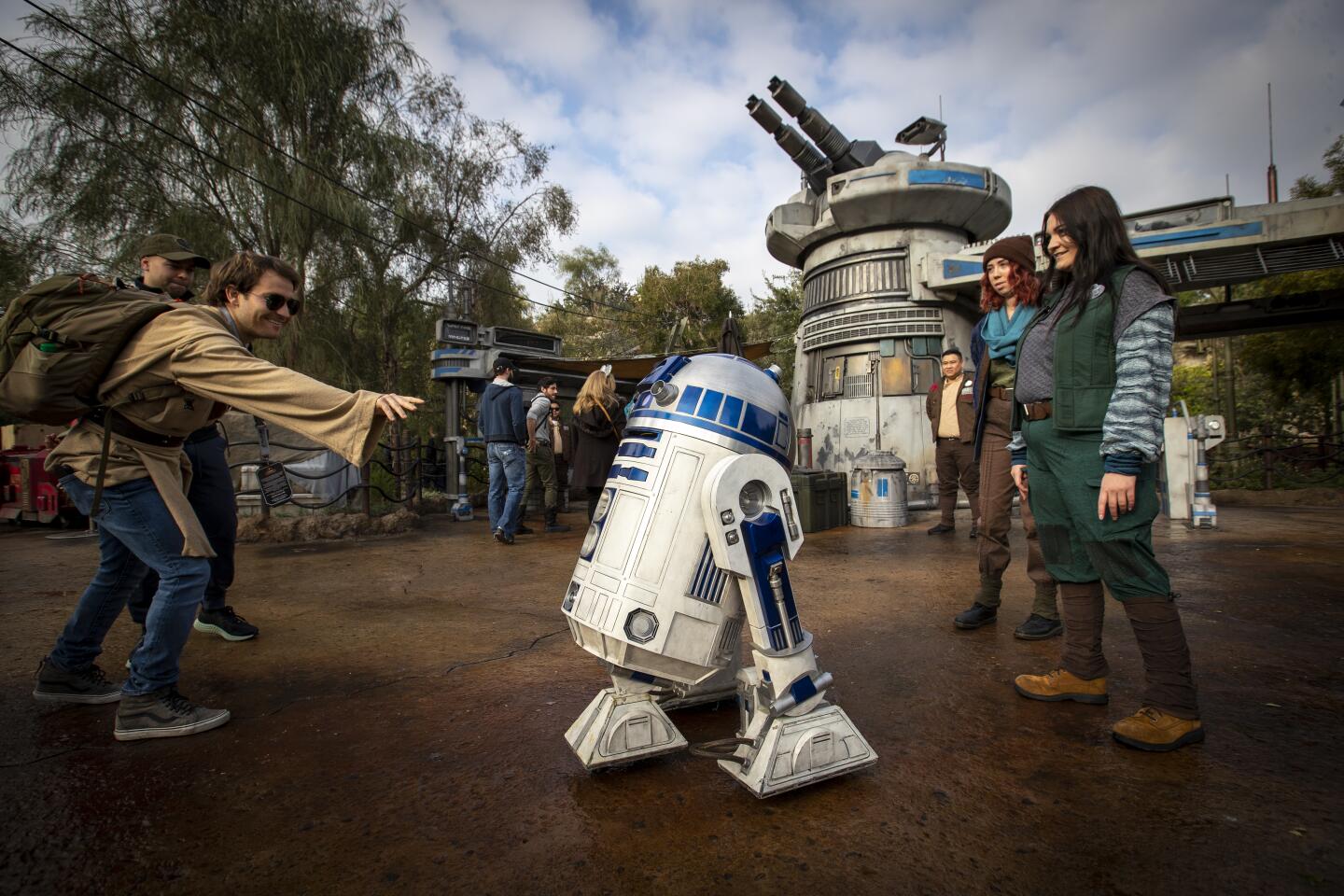Rise of the Resistance and the immersive revolution happening in our theme parks

Sit back and enjoy the ride? No more. From Disney’s new Star Wars: Rise of the Resistance to Japan’s upcoming “living video game” Super Nintendo World, theme-park audiences must participate to get the full experience.
Tracking the modern theme-park era to one specific moment isn’t easy. The parks are ever-evolving locales that must bend to commercial and cultural needs.
The 2014 introduction of interactive wands at Universal’s first Wizarding World of Harry Potter was significant. And Disney’s new Star Wars: Rise of the Resistance, which opens Friday at Disneyland and debuted last month at Walt Disney World, is being heralded as the company’s most technically advanced attraction. Yet a pivotal and public shift in theme park thinking occurred long before the current wave of interactive worlds with the 1995 opening of Disneyland’s Indiana Jones Adventure, a moderate thrill ride that takes guests over a rickety bridge and through a temple full of special effects. It’s a ride that would begin to reshape so-called “immersive” entertainment.
For one, its heavily detailed and byzantine queue has a game for guests to decode, signaling an early understanding that no part of the experience should go without play or extensive theming. More important, the actual ride aims to respond to guests. Character projections and an animatronic Indy address tourists, and a ride vehicle appears to be in conversation with them, as its sudden sputters and accelerations aim to reflect our fear, mystery and apprehension.
It was arguably the first major creation designed from the ground up for generations weaned on video games, aiming to create a future-proof product that reflects an audience demanding increased interactivity and personalization.
“They’re used to taking control, pushing the buttons and being part of the action,” now-retired Imagineer Tony Baxter said of audiences in a 1994 interview with The Times. But he may as well have been speaking of Galaxy’s Edge and its two rides, Millennium Falcon: Smugglers Run and Rise of the Resistance, which at times border on immersive theater.

“On Pirates of the Caribbean, for instance, the pirates are doing their thing and you just eavesdrop on them. Here, everything is happening because of you,” Baxter promised of Indiana Jones Adventure in 1994. Or foreshadowed. That’s not only Disney’s pitch for Galaxy’s Edge and, in particular, Rise of the Resistance, but a statement that now more than ever reflects the direction of the entirety of the theme park industry.
FULL COVERAGE: Star Wars: Galaxy’s Edge
This week in Japan, Universal began unwrapping Super Nintendo World, which is expected to open this summer in Osaka and eventually at Universal Studios Hollywood. “A life-size living video game” is the company’s objective, where it’s believed the entire land will be designed for cooperative missions and house architecture that will interface with wearable bands and smartphones. Video from a press event showed reporters jumping to punch a golden block, and it represents a movement from decorative lands to persistent ones.

This transition in thinking also will be seen in the upcoming Avengers Campus, opening this summer at Disney California Adventure. Here, the land will be a self-referential place. (Already in Guardians of the Galaxy — Mission Breakout! it’s acknowledged that we are in Anaheim.) And it’s been stated that the land will fit into a broader ongoing Marvel fiction that will connect the superhero-focused location with those in other Disney theme parks.
In turn, say goodbye, at least for the foreseeable future, to the topic-focused lands of yore such as Adventureland or Fantasyland, and think instead of story- and plot-driven lands that will place guests in the midst of an ongoing narrative, which creates new opportunities and challenges. They are, in essence, to quote the narration of the recent Disney+ docu-series “The Imagineering Story,” lands that represent a “living theater” where the guest can “play make-believe.”
There is, of course, an aspect of this approach that dates to Disneyland’s 1955 beginnings, most notably in the staged shootouts and pack mules that brought theatrics and activity to Frontierland. Tom Sawyer Island joined the latter in 1956, allowing guests to run free amid caves, trails and a suspension bridge.
Here’s a familiar and effective design trick often used at theme parks: Corral guests under or through a passageway that forces the crowd to narrow before a grand reveal.
But by and large theme park guests were audiences rather than actors, getting on vehicles to watch a show or experience a thrill.
“If there is one shift maybe that we’re making from the ’50s to now,” said Scott Trowbridge, the architect of Galaxy’s Edge, at last year’s D23 Expo, Disney’s biennial fan convention, it’s that “we’re trying to open up more room for our audience to become a part of this story. Do you guys like the idea?”
It’s a fair question, one that cuts to the core of what we want and expect out of our theme parks. It also requires guests to lean in and participate, at least if they want the full breadth of the experience. One must take the time to view the land itself as a performer. As Imagineer Joe Rohde said on a 2017 press tour of Animal Kingdom’s Pandora — The World of “Avatar,” “Now, you can choose to ignore detail and just come ride two rides; [but] you’re wasting your time at Animal Kingdom. Please pay attention to detail at Animal Kingdom.”
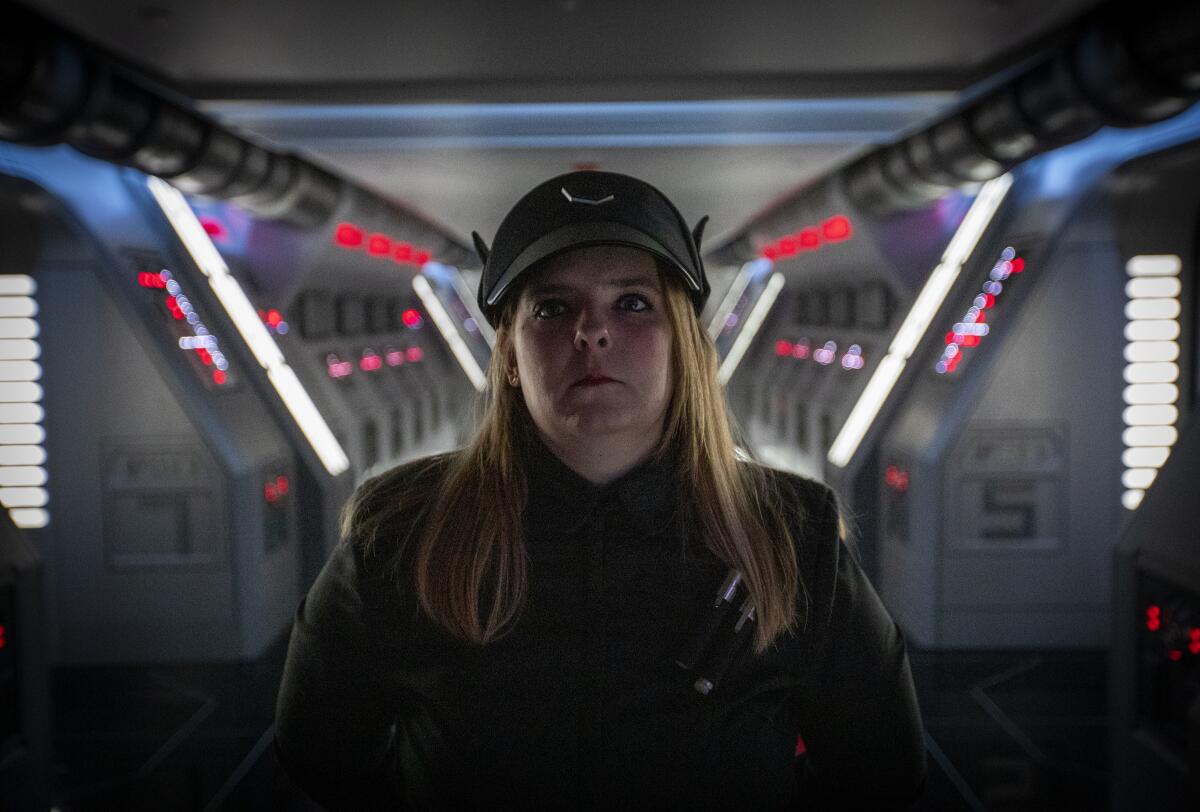
At the D23 Expo, the audience responded to Trowbridge’s question with enthusiasm. “In the world today,” Trowbridge said, “our assumption is that we see so much of a hunger to cocreate these experiences with these audiences.”
And yet bringing the participatory nature of games to our theme parks remains an unsolved challenge. Crowd-pleasing attractions such as Disney’s Toy Story Midway Mania! or Buzz Lightyear Astro Blasters were earlier attempts at responding to a digital-driven culture, essentially utilizing impressive ride systems to put guests in what would today be considered a relatively simple giant video game. Millennium Falcon: Smugglers Run is another experiment, a full-scale arcade game that gives guests the ability to pilot a ship and press a bunch of buttons.
Increasingly, however, theme park designers are looking at experiential art spaces such as the Meow Wolf collective’s House of Eternal Return in Santa Fe, or even immersive theater such as “Sleep No More” in New York, to raise the question of how willing guests might be to engage in a space on a mass scale. The challenge comes in making the individual also feel universal, and how much choice is too much.
Here’s how deep Kim Irvine’s connections are to Disneyland: About three years before she started working for Walt Disney Imagineering, the creative arm of the company responsible for theme park experiences, the then-15-year-old simply wanted her mother to stop embarrassing her.
“When I’m frustrated playing a game, I close my computer and walk away, but if I’m in a theme park I can’t walk away,” said Susan Bonds when Galaxy’s Edge opened last summer. Bonds is a former creative with Walt Disney Imagineering and the CEO of 42 Entertainment, which specializes in branded augmented-reality experiences.
“I don’t want to carry that frustration with me,” she said. “So I think, as designers, we have to ride that line. There’s a foundation of wowness that’s worth the ticket price. But then there are individual moments where there’s more risk. If I crash the Millennium Falcon, I’m bummed out, but I might get in line and do it again. ... So there’s more risk, but there’s a potential for a higher payoff.”
Like a giant role-playing game, Galaxy’s Edge comes with a rule book. While it’s spoken of as the theme park equivalent of a play set, in our backyards we make up our own narratives rather than one set permanently between the events of two films, in this case “The Last Jedi” and “The Rise of Skywalker.” That means we can’t see “Star Wars” character Rey triumphantly brandish her golden lightsaber because it doesn’t yet exist in this world, nor do we see a “baby Yoda” being escorted by the Mandalorian because their status in the world of Galaxy’s Edge is unknown.
And yet a plot-focused approach has given us the downright dazzling Rise of the Resistance, which has been impressing Walt Disney World tourists since Dec. 5, where its reservation-only line is filled daily within minutes of the gates opening at Disney’s Hollywood Studios. When it launches this week at Disneyland it will bring some much-needed adventure and action, not to mention droids and blaster fire, to Galaxy’s Edge.
It’s also a tweak to classic theme park rides, a full three-act narrative with audiences being ushered among multiple show scenes and a number of sets. At one point we’re on a transport ship. In another we’re taken prisoners and in a cell. Later, we’re on a trackless ride vehicle that becomes a flight simulator. With the trackless system, riders move forward, backward and left or right without warning, creating a sense of constant discovery.
While it uses some old-fashioned theme park tricks, including a whopping 60-plus animatronic elements, and asks its staff — cast members, in park parlance — to behave in character, it continually ups the stakes. In its early moments, cast members are heroes of the rebellion. Later, in an imposingly cold starship, they are stoic members of the evil First Order, at least until the rebellion comes to our rescue. At Walt Disney World, Stormtroopers have occasionally strolled the line to maintain the narrative illusion.
All of these elements combine to create a theme park experience that manages to feel individualized at scale. Even our ride vehicles contain a droid that is constantly communicating with and looking at us, sometimes even offering affirmative and negative reactions, not to mention fearful yelps. In one of the ride’s most thrilling moments, an animatronic of villain Kylo Ren uses the magical Force-like abilities to jerk our vehicle closer to him.

Technology, Monty Lunde, Themed Entertainment Assn. founder and president of Technifex, said earlier this year, “is allowing us to create more personalized experiences in larger venues. I see that happening more and more. People at times want to even control the experience. They want to have some ability to interact and dictate the beginning, middle and end of the experience.”
Rise of the Resistance doesn’t give guests control, but it does create the sort of believable environment in which we can feel as if we are influencing the story. While the narrative can break if a show element isn’t working — skipping, say, the transport ship, as was reported to have happened at least once in Florida, would be akin to missing a significant chunk of a movie — Rise of the Resistance will upon its opening immediately become Disneyland’s most impressive attraction. It will also at long last deliver on many of the early promises of Galaxy’s Edge.
Where Galaxy’s Edge had a sense of grandeur, now it will have life.
While exquisitely designed to represent a lived-in place home to aliens, smugglers and rebels, Galaxy’s Edge in its opening months lacked some of its teased and hyped elements — there were no smugglers, for instance, tapping you on the shoulder in the cantina. And an “upscale” dinner club was announced and then never spoken of again. It wasn’t until this month that famed blue-and-white droid R2-D2 began roaming the land. And while the Play Disney Parks app contains a hearty and enjoyable game that offers plenty of backstory — essentially the land’s third attraction — it currently does the heavy narrative lifting since special effects shows have existed largely just for media events.
Theme park lands have long lived without such elements before, of course, nor are they all entirely necessary for a land to thrive. The challenge, however, is that as these lands evolve to feel more like locations where action is unfolding in real time, the level of activity needed to maintain the illusion increases. When a land is designed to speak to us, we notice when it’s quiet.
Essentially, the more story we are given, the more story must be sustained and the more holes an audience may notice. Arguably, Millennium Falcon: Smugglers Run places too much of an emphasis on plot over play. A technical marvel, the ride has the capability of being an arcade-like romp, an interactive version, perhaps, of Star Tours (the latter is currently in its strongest Tomorrowland iteration and excitedly mixes up action and vistas). At the moment, however, Smugglers Run relies heavily on a “Star Wars” mission that’s designed for a specific time and place in the space fantasy universe, working best for those who adore “Star Wars” lore.
Try as he might — and he’s tried countless times — Rolly Crump just can’t quit Disney.
At a press event on the eve of the new ride’s opening, Imagineer Margaret Kerrison spoke of the ambitious attempt to place guests in an ongoing narrative. “Everything that happens to you today is a particular event that happens to you in the story of ‘Star Wars.’ So be prepared to be a part of ‘Star Wars’ history. You are coming in as active characters in this story.”
No doubt Disneyland’s success is its devout belief in story. Where Galaxy’s Edge presents a change is that it will continually ask guests to buy into it as a place that exists in real time. This works well at, say, Florida’s Animal Kingdom, where the stars are living and breathing creatures, but presents a marked shift from Disneyland’s past.
Imagineer Jon Georges, a principal creative executive on the land, spoke of the area as a “platform,” a term used more often in the video game industry. In a sense, Galaxy’s Edge remains something of an experiment, asking how deeply guests want to engage in our physical spaces as real-life toys.
To put it another way: No one has been confused that New Orleans Square has ghosts and pirates next to a cozy place for beignets, and the performers in Frontierland’s Golden Horseshoe aren’t in constant freak-out mode that there’s a runaway train next door. Likewise, we don’t wonder why “Cars” character Doc Hudson is dead in the current timeline of the films but alive on the ride — and then memorialized via an ofrenda during the land’s Halloween makeover.
We simply accept it all, in the same way we accept that a Kylo Ren robot is using magic on us. When we want to play — and all indications are that our entertainment conglomerates very much believe that we want to — we’re still seeking to understand by whose rules.
Further Reading
Star Wars: Galaxy's Edge
Key L.A. Times stories on Disney’s Star Wars: Galaxy’s Edge
More to Read
The biggest entertainment stories
Get our big stories about Hollywood, film, television, music, arts, culture and more right in your inbox as soon as they publish.
You may occasionally receive promotional content from the Los Angeles Times.
